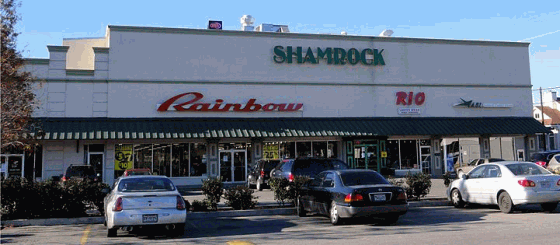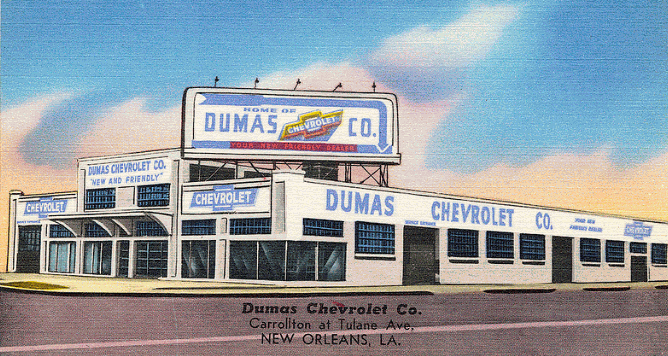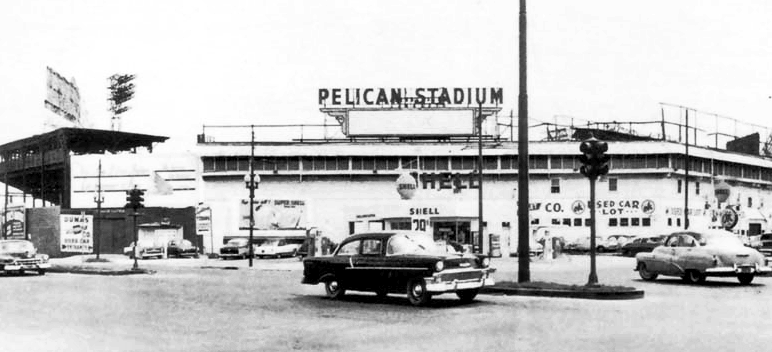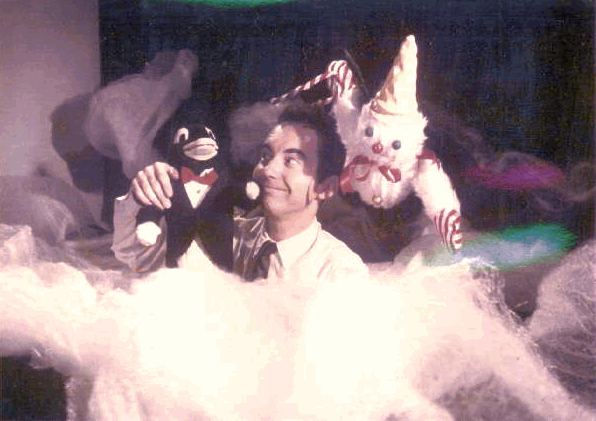|
Today in New Orleans History |
|
|
November 23


The present Jesuit High School was formerly only one department of the College of the
Immaculate Conception which was founded in 1847 by the Fathers of the Society of Jesus (the Jesuits) for the education of
young men. The College was situated on Baronne and Common Streets; but at the close of the 1910 – 1911 session, the
collegiate departments were transferred to the site of the present Loyola University of New Orleans. The high school department,
however, was retained in the buildings on Baronne Street. This change was the result of a large increase in enrollment in
both the college and the high school departments. A recreation center and gym was
constructed on Banks Street across from the school in 1957 and provided facilities for the athletic teams and the physical
education program. A spacious Resource
Center, featuring the library, additional classrooms, and science facilities was built in 1974. The Resource Center,
located opposite the main entrance on Carrollton Avenue, was constructed in response to increased enrollment and further individualization
of instruction. In 1982 four floors of the Jesuits’
residence on Banks Street were renovated, a project which added 10 classrooms and provided new offices for the administration
and staff. A year later the cafeteria was enlarged. A new physical education facility — the Louis J. Roussel, Jr. Building — was constructed in 1986 adjacent to
the existing gym and included classrooms, athletic meeting rooms, and offices for coaches.
Mary Loretta Landrieu was born in Arlington,
Virginia on November 23, 1955. She was raised in New Orleans and attended Ursuline Academy.
She graduated from Louisiana State University in Baton Rouge in 1977, where she was a member of Delta Gamma sorority. Before entering
politics, she worked as a real estate agent.
On November 23, 1900, the firm of Sully, Thomas and Stone Brothers submitted plans for an office
building at 600 Canal Street for the Tulane Educational Fund. Born in New Orleans on November
23, 1888, Alfred A. "Al" Bernard was an American vaudeville singer,
known as "The Boy From Dixie", who was most
popular during the 1910s through early 1930s. He was a blackface singer
in minstrel shows before starting his recording
career around 1916. He was one of the first white singers to record blues songs. W. C. Handy credited Bernard with helping his own career by recording a number
of his songs, notably "St. Louis Blues". Bernard
recorded the song for nine different record labels, the most successful being what Handy called "the sensational Victor recording
in which he sang with theDixieland Jazz Band". From
1919, he recorded solo for Okeh Records. His songs
included one called "Shake, Rattle and Roll", about
a dicegame, which was wholly unrelated, except in
title, to the later rock and roll song. Bernard
was sometimes billed as "The Singing Comedian", and was the first American singer to record the song "Frankie and Johnny" in America. He also recorded duets with Ernest Hare, in which Bernard took the female singing part, including his biggest
hit, "I Want To Hold You In My Arms". He recorded with songwriter J. Russel Robinson as "The Dixie Stars" and, with Robinson, wrote the Bessie Smith feature "Sam Jones Blues". He also co-wrote songs with Jimmy Durante. Later, he recorded with Vernon
Dalhart. In 1925, inspired by Dalhart, he began recording hillbilly songs. His 1930 version of "Hesitation Blues", recorded with the Goofus Five, is considered to predict the western swing style, with an intriguing combination of country and western and Chicago blues feels. Bernard
continued to record into the 1940s. He died on March 6, 1949 in New York City. (Wiki)
This industrial aerial photo on the left, from the New Orleans Public Library, captures the view on
November 23, 1952. On the right is a capture of the same intersection today. Through the years this intersection
has been many things for many people. In 1903, C. Werbeck's blacksmith shop shop was here. In 1905, Mr. Morto's
horse and buggy were found abandoned here. On August 16, 1906, Athletic Park Amusement Company's arcade,
casino, band building, ice cream building, and Japanese building were up for auction where Pelican Stadium would later reside.
White City amusement park took its place in 1907. The Pelicans began playing baseball here around 1913. In 1939, M.
B. Hardy set up a "gaily beautiful sales yard" complete with camellias, azaleas, evergreens, rose bushes, and native
shrubs where the Mid-City Shopping Center would later locate. The Krewe of Endymion began their extravagant parades
here. This intersection was a busy hub of activity for many years. The same photo as above, zoomed in for a tighter view shows the railroad underpass on Carrollton which had been opened
to traffic about three months before the photo was taken on November 23, 1952. It was part of the extensive
Union Passenger Terminal Grade Separation Program, designed ease auto traffic throughout the city. In the photograph is also
Pelican Stadium (right) on the corner of Tulane Avenue and South Carrollton Avenue, Mid-City Shopping Center (catercorner
to the stadium), Riecke Cabinet Works (left of the shopping center on Carrollton), and Dumas Chevrolet (across Carrollton
Ave. from the Stadium). The then newly-filled New Basin Canal runs along the bottom of the photo, parallel to the train
tracks. Once a thriving navigational canal which had connected Lake Pontchartrain to the heart of the city, much of its path
was replaced by the Pontchartrain Expressway and the neutral ground between West End and Pontchartrain Boulevards.
The company's work could be seen at Howard-Tilton Library, the LSU
medical building, Gentilly Presbyterian Church, Katz & Besthoff on Canal Boulevard, St. Rita's Church, St. James Major
Church, the Xaivier University Chapel, Notre Dame Seminary, First Baptist Church, Pontchartrain Motor Company, and the Supreme
Court main court room. The fourth grader who was forced to drop out of McDonough grammar school
on South Rampart and Girod Street to work odd jobs, Henry Riecke passed away on June 24, 1965 at the age
of 84 a very successful businessman. He was also president and owner of Tulane Hardware and Lumber Company, Inc.
His sons continued to run Riecke Cabinet works after his death. Robert Ernest "Dumas" Milner, who owned Dumas Chevrolet Company, was the Tom Benson of Jackson,
Mississippi -- a self-made millionaire who made a fortune through turning small companies into large profitable ones, opening
car dealerships, buying and selling real estate, and generally making everthing he touched turn to gold. "Dumas"
was a nickname given his after he began following a hired hand by that name around his family's cotton farm. At age 7 he hawked
Rosebud Salve elixir to his rural neighbors. As a young man he took over Magnolia Chemical Company who employed six peope
to produce their patented Pine-Sol and other cleaning products, and turned it into a $10 million per year company with 86
warehouses, and sold it to American Cyanamid for $17 million. He bought hotel and real estate, owned the tallest building
in Jackson, began an exporting business, and acquired National Car Rental. He was Chief of Staff of Mississippi Governor John
Bell Williams and owned Henderson Mansion in Pass Christian. With a somewhat quirky (but true to his times) business philosophy,
he refused to hire a man to a key position until he met the man's wife. When the Dumas dealership
formally opened at 4049 South Carrollton on August 30, 1952 at 8 a.m., gifts were given to the ladies and
Val Barbara and his Orchestra played. The air-conditioned showroom was modern in every way. The repair shop was stocked
with $50,000 worth of parts and equipment. Thirty-five employees were on duty, with 80 more expected to be brought on
during the next six months. Ben Howard Nelson was the vice-president and general manager, W. N. Newt Godfree was the GM, Herbert
P. Jackson served as service manager, S.K. Martin the business manager, J. Clyde Carter was in charge of parts, Alex Holliday
was truck manager, and Henry Carter was the used car head man. By the time the dealership celebrated its second anniversary,
it had added a used car lot at 3925 South Carrollton. By 1956, Dumas had four dealerships in New Orleans, including
locations at 215 South Claiborne (between Tulane and Canal) and in Kenner at Airline Highway at Clay Street. The beloved Pelican Stadium has a long history of its own (much too long to feature here) but for
baseball fans, this sight (right) must have been heartbreaking. On October 16, 1956, Dumas announced
the opening of a new car lot at Pelican Stadium. A want-ad published in the Times-Picayune that day sought new and used
car salesmen to work it..."Apply in person to Bill Watson". From 1915 the New Orleans
Pelicans (the first professional sports team in New Orleans) called it home, as did the Black Pelicans and the Creole Negro
teams. Pelican/Heinemann Stadium also allowed local fans to view major league exhibition and training games and to get
a glimpse of stars such as Babe Ruth, Jackie Robinson, and Hank Aaron. The stadium was demolished in 1957. It
was replaced by the Fontainebleau Hotel which was was later converted into a storage facility. Happy Birthday, Al Shea Photo from the Broadcast Museum Al Shea, born Alvin Francis Caserta, Jr. in New Orleans on November 23, 1927, was a popular local actor
and theatre critic. He spent his early childhood in Paducah, Kentucky, where his father obtained employment. While still
a boy, his parents divorced. His father remained in Kentucky, where he re-married. His mother returned with her son to her
family in New Orleans. Al's name was then officially changed to Alvin John Shea, Shea being his mother's maiden name. At the
age of ten, Shea was heard on WWL radio as Jackey, in the serial, "The Life of Peggy Hill." His stage debut was
as Tip in The Land of Oz, in 1941, at Le Petit Théâtre du Vieux Carré. Shea
served in the Navy, and was a Tulane graduate. In 1955, he joined the staff of WDSU-TV, replacing Ed Nelson on "Tip-Top
Space Ship," as Sparky. He then had success as Deputy Oops in "Adventures in Fun," in 1960. A bigger success
followed when he was the voice of Pete the Penguin on Mr. Bingle broadcasts. He was also producer of the station's "Second
Cup" show, with Bob and Jan Carr and served as entertainment critic on "Midday" (1963–73), with Terry
Flettrich, where he interviewed many stars of the theatre and cinema. Throughout his career, Shea wrote on various facets
of the Fine Arts and of entertainment for varying media, and was often heard on radio, as well. Shea covered theatre for several years for Gambit (until
1995), and, for twenty-three years, was theatre critic on WYES's "Steppin' Out," with Peggy Scott Laborde. His final
appearance on the program was only two months before his death, from cancer, at the age of eighty-one. Al Shea died
on August 20, 2009, in New Orleans. His funeral mass was held at St. Louis Cathedral. (Wiki) |
|
|

To receive an update for each day in New Orleans history,
join our facebook page - Today in New
Orleans History.
Analytics |

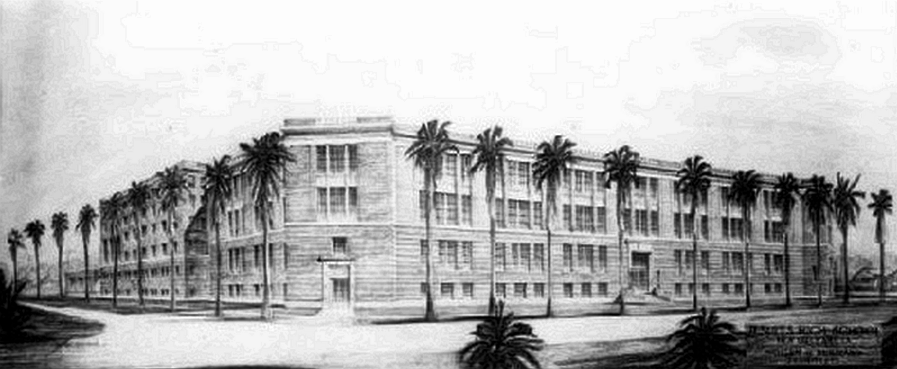

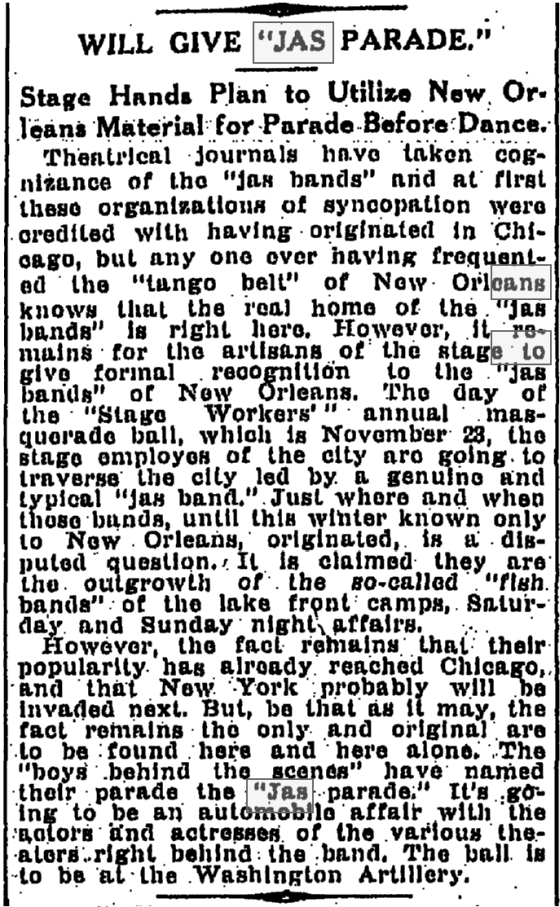
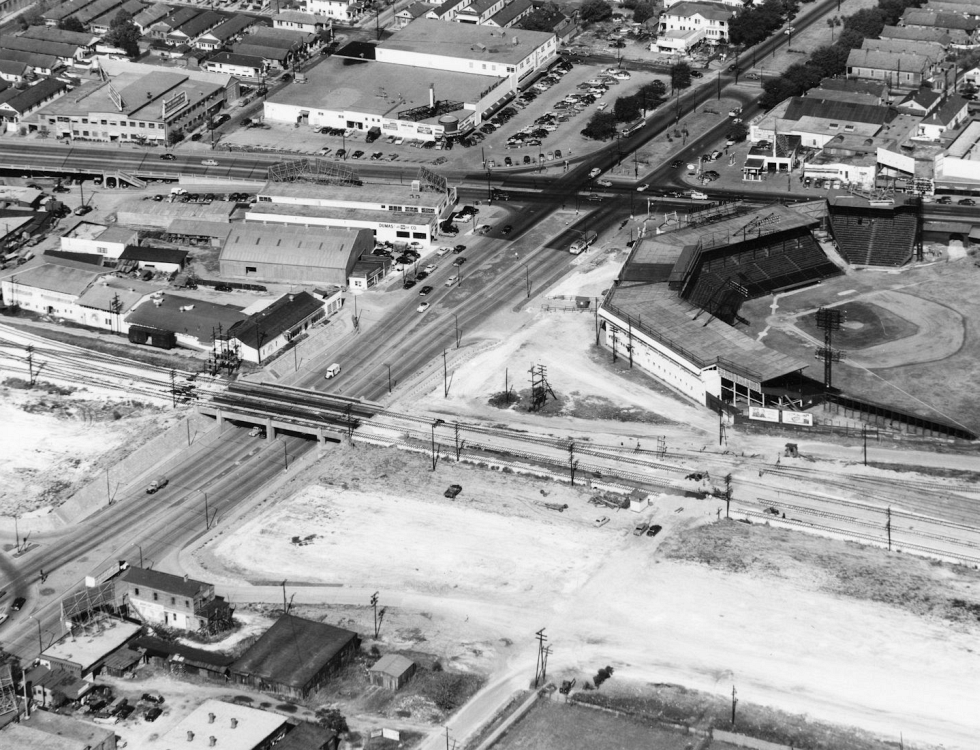
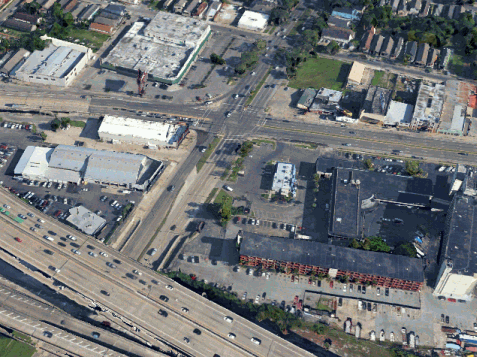
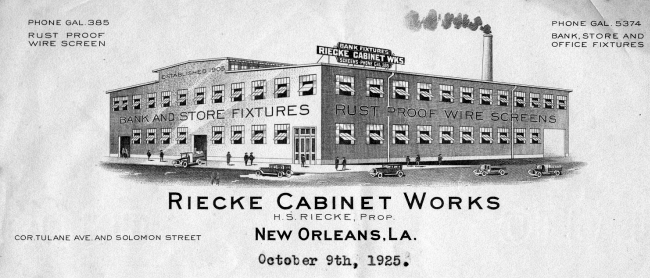 Riecke Cabinet Works, Inc. at 4102 Tulane manufactured furnishings for offices, banks, stores, and churches. It was
founded by Henry Sebastian Riecke in 1904 witha $1000 investment and a small building on Magazine Street at Girod. Riecke's
excellent work and satisfied customers allowed him to move to a larger facility at Tchoupitoulas at Girod. Another expansion
occurred when he move the business to Annunciation at Girod until 1924 when he built the large plant pictured. Riecke was
among the first to produce and sell radio cabinets in the city. He made the pews and fixtures for Grace Evangelical
Church, which were moved to the congregation's new location at 5800 Canal Boulevard. One of his proudest accomplishments was
the creation of the Archbishops throne for St. Louis Cathedral during the mid-1940s. In all, the company company furnished
over 1200 churches around the world, employed as many as 120 persons during peak seasons, and was one of the largest company
of its kind in the South.
Riecke Cabinet Works, Inc. at 4102 Tulane manufactured furnishings for offices, banks, stores, and churches. It was
founded by Henry Sebastian Riecke in 1904 witha $1000 investment and a small building on Magazine Street at Girod. Riecke's
excellent work and satisfied customers allowed him to move to a larger facility at Tchoupitoulas at Girod. Another expansion
occurred when he move the business to Annunciation at Girod until 1924 when he built the large plant pictured. Riecke was
among the first to produce and sell radio cabinets in the city. He made the pews and fixtures for Grace Evangelical
Church, which were moved to the congregation's new location at 5800 Canal Boulevard. One of his proudest accomplishments was
the creation of the Archbishops throne for St. Louis Cathedral during the mid-1940s. In all, the company company furnished
over 1200 churches around the world, employed as many as 120 persons during peak seasons, and was one of the largest company
of its kind in the South. 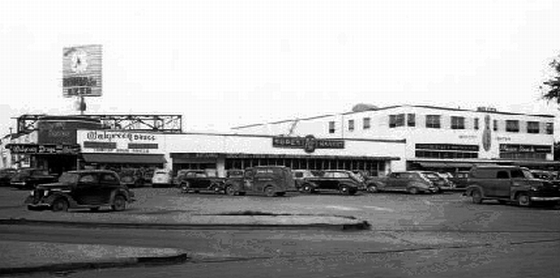 Mid-City Shopping Center is pictured on the left during the early 1940s. At the time it housed a Walgreen's, an
A&P grocery store, and the Mid-City Bowling Lanes which would later become Rock 'n' Bowl (which has now relocated
a few blocks away on Carrollton Avenue behind what was Ye Olde College Inn). On the right is the former location
of Mid-City Lanes/Rock 'n' Bowl, now Shamrock night club.
Mid-City Shopping Center is pictured on the left during the early 1940s. At the time it housed a Walgreen's, an
A&P grocery store, and the Mid-City Bowling Lanes which would later become Rock 'n' Bowl (which has now relocated
a few blocks away on Carrollton Avenue behind what was Ye Olde College Inn). On the right is the former location
of Mid-City Lanes/Rock 'n' Bowl, now Shamrock night club.